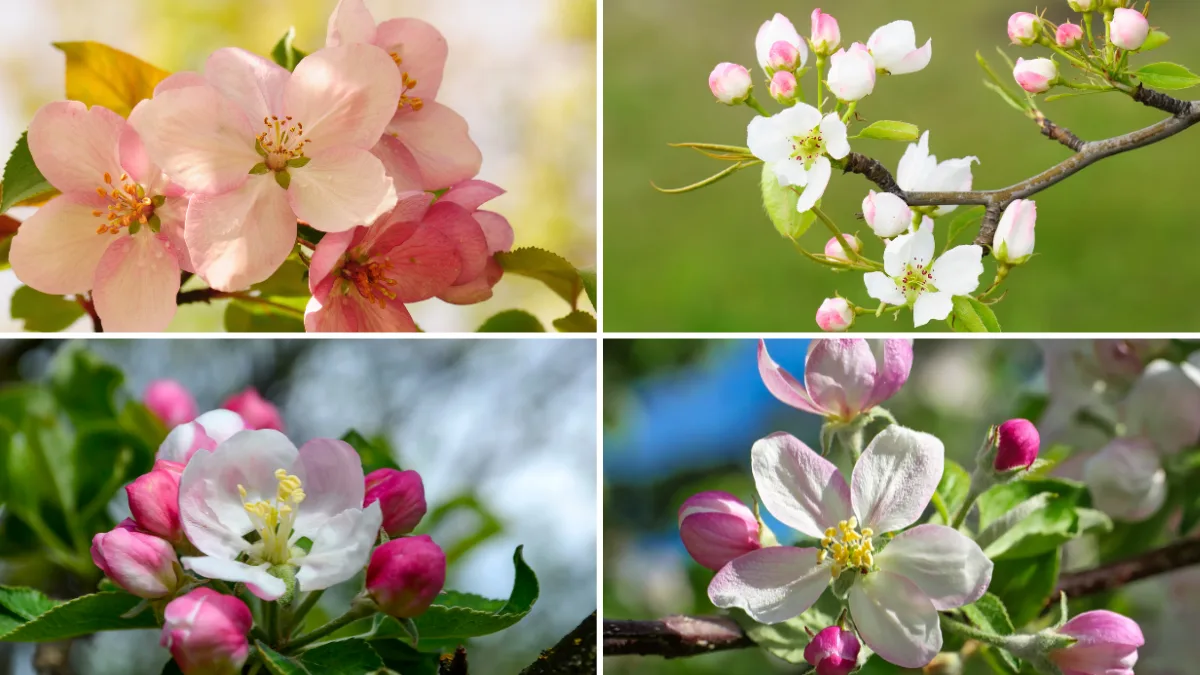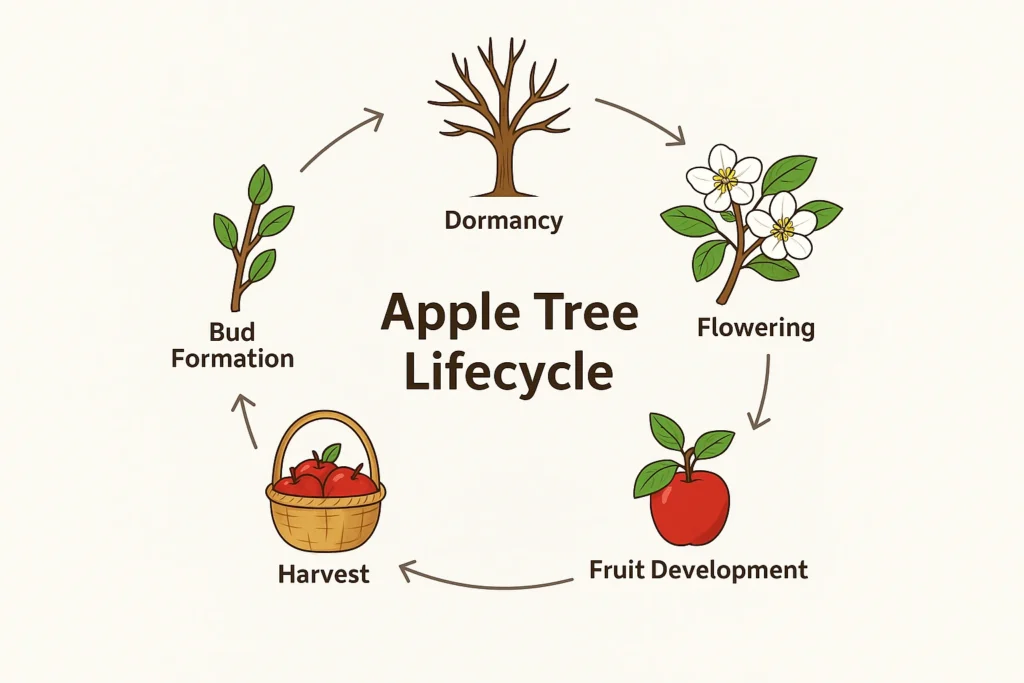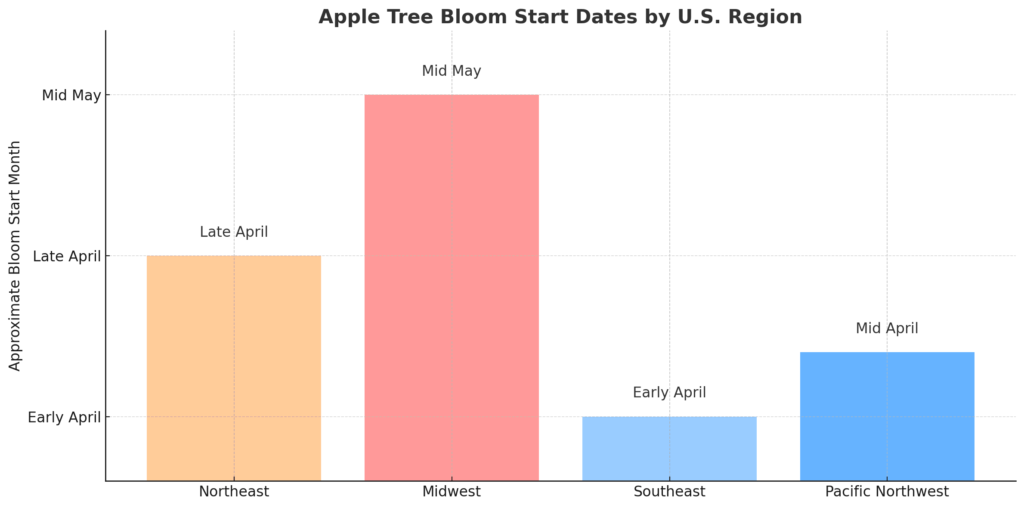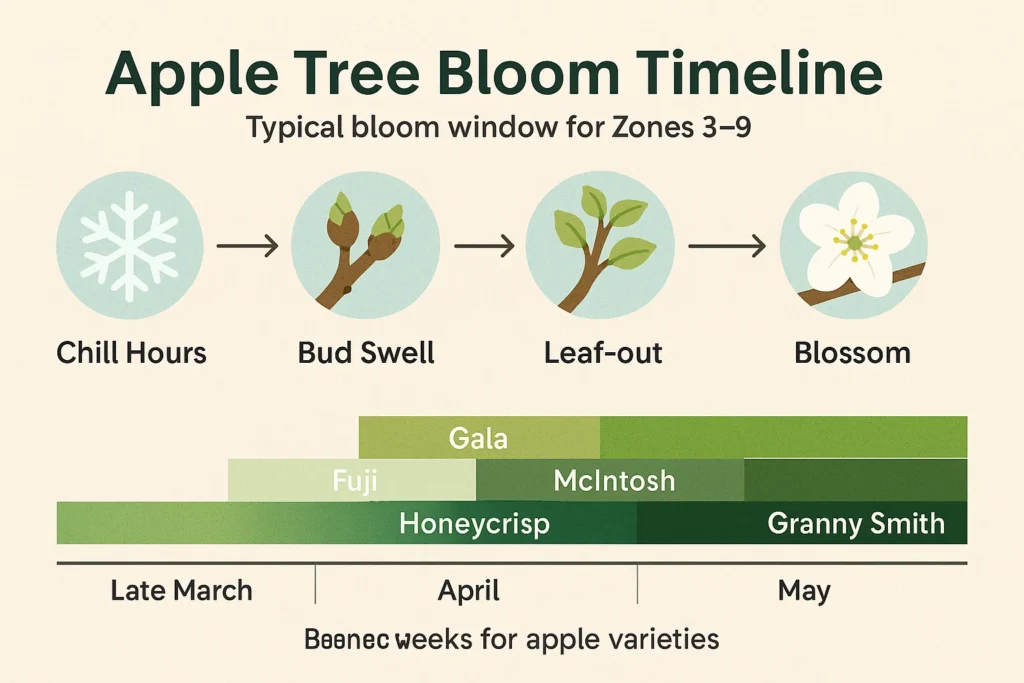When Do Apple Trees Blossom? A U.S. Grower’s Guide to Bloom Time and Fruit Buds

Apple trees are a staple in home orchards, prized for their beauty, reliability, and fruit production. Whether you’re managing a few backyard trees or planning a small orchard, one of the most common and essential questions is: when do apple trees blossom?
In the U.S., apple trees typically blossom between mid-April and mid-May, depending on where you live and the type of apple you’re growing. Bloom timing can vary based on climate, USDA hardiness zone, and each tree’s chill hour requirement. Getting familiar with these factors is key to proper timing for pruning, pollination, and fruit set.
Table of Contents
The Lifecycle of an Apple Tree: From Dormancy to Blossom
Let’s start with the plant itself. Apple trees (Malus domestica) are deciduous trees that thrive in temperate zones across the U.S. They go dormant in winter, conserving energy until temperatures warm enough in spring to resume growth.
During winter dormancy, apple trees require a certain number of chill hours—periods when the temperature stays between 32°F and 45°F. This chilling period resets the tree’s internal clock. Once fulfilled, buds begin to swell, leaves emerge, and soon after, apple fruit buds open into blossoms.
So, when do apple trees blossom in the U.S.? Typically 3–4 weeks after the first green leaves appear, which varies by location and cultivar.
When Do Apple Trees Bloom in the U.S.?
In the U.S., when do apple trees bloom depends heavily on your USDA planting zone, regional climate, and the variety you plant. Here’s what you can expect:
- Zone 3–4 (Northern Midwest, upper New England): Bloom begins around mid to late May
- Zone 5–6 (Northeast, upper Midwest): Look for blossoms between late April and early May
- Zone 7–8 (Mid-Atlantic, Pacific Northwest): Trees may bloom as early as mid-April
- Zone 9 (Northern California, inland Southeast): Some early-blooming types may open in late March to early April
Cooler zones naturally bloom later due to longer winters, while warmer zones tend to see earlier bud break and flower development. If you’re unsure about your zone, check it here: What Planting Zone Am I In?
Regional Bloom Timing Across the U.S.
Here’s a closer look at bloom timing by U.S. region to help answer the question: when do apple trees blossom where you live?
Northeast (NY, PA, VT, ME – Zones 5–6):
Most varieties bloom between late April and early May, depending on snowmelt and soil warmth.
Midwest (MN, WI, MI – Zones 3–5):
Blossoms usually appear in mid-May, with frost often a concern in early spring.
Pacific Northwest (WA, OR – Zones 7–8):
Apple trees bloom between mid-April and early May, ideal conditions for late varieties like Honeycrisp.
Southeast (NC, TN, GA – Zones 7–8):
Expect bloom as early as early to mid-April, especially in protected valleys and lower elevations.
California (CA – Zones 8–9):
In the Sierra foothills and inland valleys, bloom can start in late March, depending on winter rainfall and temperatures.
If you’re unsure about your zone, check it here: What Planting Zone Am I In?
Identifying Apple Tree Flowers and Fruit Buds
Knowing what to look for makes planning easier.
- Apple tree flowers are five-petaled, usually white with hints of pink.
- Fruit buds are rounder and larger than leaf buds. They appear at the tips of spurs on older wood.
- Flowering typically starts from the inside branches out — warmer wood blooms first.
So when you see these buds swell and open, you’re observing when do apple trees blossom in real time — a critical cue for fertilizing and frost protection.
When Do Apple Trees Produce Fruit?
After flowering, fruit production begins — but how long does it take?
- Apples typically take 90 to 120 days from blossom to harvest.
- Harvest windows vary: early varieties like Lodi may ripen by July, while late ones like Fuji go into October.
- Without proper pollination (bees, compatible trees nearby), blossoms will not form fruit.
To estimate productivity or plan future plantings, use our Tree Age Calculator to determine the maturity and blooming potential of your existing trees.
What Impacts Bloom Time in Apple Trees?
Several environmental and cultural factors influence when apple trees blossom in the U.S.:
- Chill Hours: Not meeting the required hours can delay or prevent blooming altogether. Some low-chill cultivars are bred for warmer states.
- Pruning Practices: Correct winter pruning increases flowering. Prune too late, and you might cut off this year’s fruiting wood.
- Late Spring Frosts: Flowers are sensitive to frost, especially at full bloom. Monitor your local frost date carefully.
- Soil & Water Stress: Poor soil health or drought conditions during dormancy can delay bud break.
How to Support Healthy Blooming?
A well-blooming tree starts with consistent care. If you’re wondering when do apple trees blossom and how to support them when they do, here are a few tips:
- Prune annually in winter to maintain fruiting spurs and airflow
- Mulch the root zone to retain moisture and suppress weeds
- Water deeply in late winter and spring if rain is scarce
- Apply a balanced fertilizer in early spring before bud break
Poor bloom one year doesn’t mean the tree is finished — it often signals the need for better soil, more sunlight, or more pruning.
Tools & Calculators to Plan Your Orchard
If you’re managing multiple trees or planning your orchard layout, our site offers practical calculators to help you take the guesswork out of timing and measurements:
These tools are designed to support growers at every stage, from planting to pruning to predicting harvests.
Explore More Growing Guides
For advanced research and insights on plant development, see this guide from ScienceDirect — a trusted resource for evidence-based horticulture.
FAQs: Apple Tree Blooming in the U.S.
What season do apples grow in California?
Apples grow in late summer to early fall in California, typically from August through October.
What months do apples blossom?
Apple trees typically blossom in April and May.
What is the fruiting month of apples?
Apples usually begin fruiting between August and October, depending on the variety and location.
What is the lifespan of an apple tree?
The average lifespan is 35–50 years, though some can live up to 80–100 years with proper care.
What is the season of apple fruit?
Apple season runs from late summer through fall, peaking between September and October.
When do apple trees blossom in Zone 6?
Most bloom between late April and early May, depending on local weather patterns.
What’s the best time to prune apple trees?
Late winter to early spring, before bud break but after deep freezes.
Why isn’t my apple tree blooming?
Common causes include lack of chill hours, over-pruning, nutrient deficiency, or insufficient light.
Can one apple tree bloom alone and bear fruit?
Most apple trees need a second variety nearby for cross-pollination and successful fruit set.
Conclusion
To recap: when do apple trees blossom in the U.S.? Most commonly, between mid-April and mid-May, depending on your hardiness zone and cultivar. Understanding your tree’s bloom cycle is essential for managing pollination, fruiting, and care throughout the year.
Whether you’re new to apple trees or an experienced grower, staying informed on bloom timing helps you get the most from your trees. Use our calculators, browse our seasonal guides, and stay ahead of your region’s growing curve.



